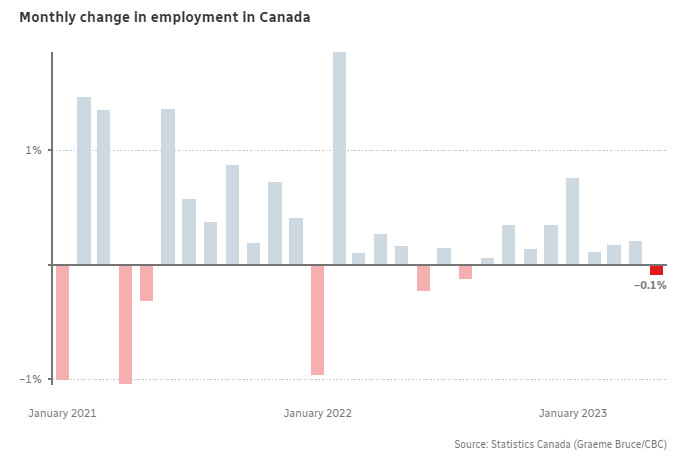Canada is undoubtedly the most renowned and popular study destination among Indians. Nearly 4% of the Canadian population is Indian, the second highest among the total Asian races residing in Canada.
Many Indian students prefer to study in Canada and eventually settle there. This is a common trend in India, which records the highest number of immigrants in Canada in 2022. However, job opportunities in this multicultural country have declined rapidly for the past few months. This is directly impacting the influx of international students to this country.
In this article, we will identify the underlying reasons for the decline, its alternatives, and whether students should opt to study in Canada amid such circumstances.
The decline in job opportunities:
As per the report of Bloomberg, the jobs in the second quarter of 2023 declined steadily each month. Canada witnessed around a 1.2% decline in jobs from May to June.
The unemployment rate also decreased steadily by a margin of 0.1% from 5.4% in June to 5.5% in July and the following months, the latest Labor Force survey of Canada highlighted.
By the end of the second quarter, the seasonally adjusted job change rate was recorded at the lowest since the pandemic in 2020.
Most of this decline was contributed by the plummeting vacancies in the Finance, hospitality, and construction industries, most of which were part-time and temporary jobs. On the other hand, healthcare and social services were the least impacted.

The drivers of declining job opportunities in the country:
As per the annual report of the World Economic Forum, the highest job displacement is the slow economic growth globally, which resulted in a 74% decline in jobs in Canada. This was followed by increased adoption of artificial intelligence and migration of industries to digital solutions.
As a result, most declining jobs are low-skilled jobs that machines can easily replace. Some of these jobs include- Assembly and factory workers, general operation managers, data entry clerks, accounting, bookkeeping, and payroll clerks, the World Economic Forum Report highlighted.
The declining jobs directly hit the migrant population:
In Canada, 20% of the population is immigrants, the highest in the world. In addition, around 11% of this population is aged between 15-24 years, and more than 60% are between the young age group of 25-54 years.
As noted earlier, most job decline is witnessed in the low-skilled jobs, which immigrant workers and full-time students frequently fill. This directly impacts the employment of international migrants to the country.
Even the survey by the president of the University of Calgary Students’ Union- Shaziah Jinnah Morsette- suggests that 4 out of 5 university students struggle to find part-time and full-time internships in the country, highlighting the pain and agony of students.
Interestingly, compared to the overall unemployment rate (5.5%), the unemployment among 15-24-year-olds is more than double (around 11%). This means that more than 11% of the young population is struggling to find jobs and sustain in Canada amid the global economic slowdown.
Rise in student exploitation:
Amid the rise in the unemployment rate, job-seeking candidates, mostly students, are faced with exploitation. They are required to work longer hours to pay their bills. Most of these tensions have increased due to some mandatory labor law changes for international students.
Last year, the government lifted the 20-hour/ week working cap for all international students, allowing them to work longer than 20 hours at their full-time jobs.
This, on the one hand, has allowed students to earn more amid the rising cost of living but has also exposed the students to exploitation on the other hand.
The impact of the international education industry:
Despite the rise in the unemployment levels in the country, the influx of international students has been strong. In 2022, more than 551,405 international students crossed the borders of Canada. For 2023, Justin Trudeau, the Prime Minister of Canada, plans to host at least a million international students in the country.
And since Canada is the fastest growing economy among G7 nations after the US, economists expect that the unemployment rate will rebound soon as April 2023 witnessed the lowest unemployment rate.
So, experts predict that the employment dip is temporary and expected to rise in the coming months.
Alternatives for students:
For all the students pre-existing in Canada, low-skilled jobs are declining. So, students should delve into jobs in big data, AI, cyber security, e-commerce, education, social services, and workforce development technologies. All of these sectors are witnessing a boom in Canada, the World Economic Forum highlights.
For the students who wish to go to Canada, experts predict that it is not the best time to study in Canada. Students can wait a year or consider admission to another country, such as New Zealand or the UK.
Indian students in Canada:
Delving at the particular case of India, since Canada linked the murder of Khalistan leader Hardeep Singh Nijjar with India, the political tensions between the two nations have adversely impacted the influx of Indian students to Canada. In fact, during the end of September, the Government of India temporarily suspended visa services to Canada due to administrative disturbances.
The government also advised all Indians in Canada to exercise precaution amid tense situations. Experts warn Indian students to hold their horses until the next academic session in 2024 when tensions between the two nations deescalate.
In early 2023, more than 700 Indian students faced deportation from Canada amid study visa fraud.

